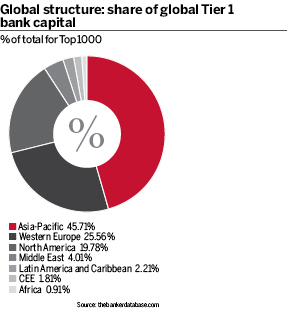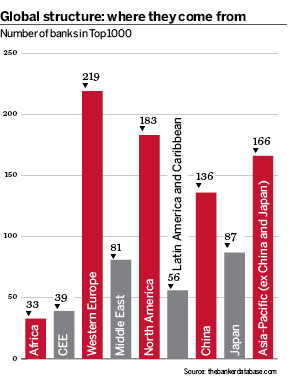Based on the results of the 2019 Top 1000 World Banks Ranking, the global banking sector is in excellent health with performance improvements being achieved across the board. Most encouragingly of all, total pre-tax profits have continued to move in the right direction, hitting $1136bn, up from $1112bn in the 2018 ranking. This marks the second year in a row in which pre-tax profits have increased on a global level, following a period between the 2015 and 2017 rankings, when they fell.
Beyond this improving picture for pre-tax profits, total Tier 1 capital has also expanded, albeit marginally. But considering that in the 2018 ranking, Tier 1 capital grew by an impressive 11.7%, even the marginal rise in the 2019 edition underscores an encouraging direction of travel. In the return on capital (ROC) stakes, the 2019 ranking shows a drop of 2.63 percentage points to 10.87 but this is due to a change in the method of calculation using net income rather than pre-tax profits. Calculated the other way the figure would have been 13.68%, up slightly from 13.5% in the 2018 ranking. Return on capital has been in the 13% to 15% range for the past six years.
The total assets of the world’s Top 1000 world banks is the only metric that has suffered a decline. In the 2019 ranking total assets dipped slightly to $122,800bn, from the $123,700bn registered in 2018. Meanwhile, the global structure of the Top 1000 World Banks illuminates a number of trends. For one, the Asia-Pacific region’s percentage of global Tier 1 capital continues to grow at a rapid pace. The region accounts for 45.71% of all Tier 1 capital in the 2019 ranking, which is a notable increase on the 44.35% it recorded in the 2018 edition.
Elsewhere, other global regions have either maintained their percentage share or experienced small declines. Western Europe’s share of Tier 1 capital has decreased to 25.56% in the 2019 ranking from 26.83% in the 2018 ranking. Over the same period, North America and the Middle East have maintained the same percentage share of 19% and 4%, respectively, while Latin America and the Caribbean, central and eastern Europe and Africa have retained an almost stable share of global Tier 1 capital.
In terms of the number of banks in the ranking, Africa and western Europe have increased their share by one lender each in the 2019 edition. North America has experienced a more notable increase by contributing eight extra banks to the ranking. Japan also makes an impression by adding an additional two banks. Meanwhile, the number of Chinese lenders has fallen by one, while banks from the Asia-Pacific region (excluding China and Japan) have been reduced by three. The only other notable reduction in banks comes from the Middle East, which has seen its contribution to the ranking fall by a total of three lenders. In part, the drop in Middle Eastern banks can be attributed to the wave of consolidation that is currently sweeping across the region.






